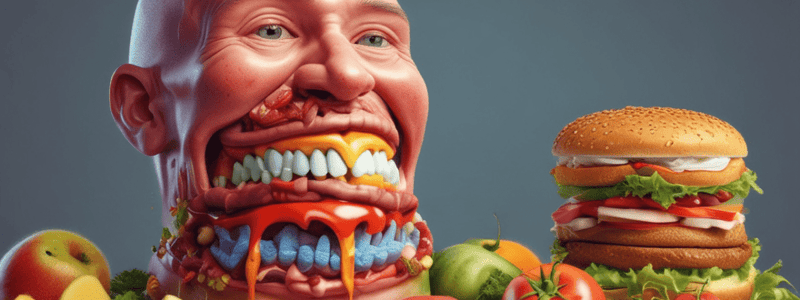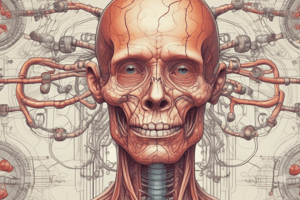Podcast
Questions and Answers
What is the primary function of neuropeptide Y (NPY) neurons in the arcuate nucleus?
What is the primary function of neuropeptide Y (NPY) neurons in the arcuate nucleus?
- Inhibit the release of melanocortin hormones
- Decrease food intake and increase energy expenditure
- Stimulate insulin secretion and metabolism
- Increase food intake and reduce energy expenditure (correct)
Which neurotransmitter stimulates the release of orexin and melanin-concentrating hormone (MCH) in the lateral hypothalamus?
Which neurotransmitter stimulates the release of orexin and melanin-concentrating hormone (MCH) in the lateral hypothalamus?
- Ghrelin
- Leptin
- Glucagon-like peptide-1 (GLP-1)
- Endocannabinoids (correct)
What is the primary function of POMC neurons in the arcuate nucleus?
What is the primary function of POMC neurons in the arcuate nucleus?
- Decrease food intake and increase energy expenditure (correct)
- Inhibit the activity of melanocortin receptors
- Increase food intake and reduce energy expenditure
- Stimulate the release of NPY and AGRP
What is the primary target of α-MSH released by POMC neurons?
What is the primary target of α-MSH released by POMC neurons?
What is the primary function of AGRP in the arcuate nucleus?
What is the primary function of AGRP in the arcuate nucleus?
Which nucleus plays a role in controlling insulin secretion and metabolism?
Which nucleus plays a role in controlling insulin secretion and metabolism?
What is the primary role of insulin in the long-term control of body weight?
What is the primary role of insulin in the long-term control of body weight?
What is the main function of the nucleus tractus solitarius (NTS) in the short-term control of meals?
What is the main function of the nucleus tractus solitarius (NTS) in the short-term control of meals?
How does cholecystokinin (CCK) act as a satiety signal for regulating meal size?
How does cholecystokinin (CCK) act as a satiety signal for regulating meal size?
Which of the following is NOT a mechanism by which the nucleus tractus solitarius (NTS) contributes to the short-term control of meals?
Which of the following is NOT a mechanism by which the nucleus tractus solitarius (NTS) contributes to the short-term control of meals?
How does the increase in insulin secretion that accompanies nutrient abundance affect the NPY-secreting cells of the arcuate nucleus?
How does the increase in insulin secretion that accompanies nutrient abundance affect the NPY-secreting cells of the arcuate nucleus?
What is the primary role of the hypothalamus in maintaining energy balance?
What is the primary role of the hypothalamus in maintaining energy balance?
What is the primary role of insulin during the fed state?
What is the primary role of insulin during the fed state?
Which of the following accurately describes the fasting phase?
Which of the following accurately describes the fasting phase?
What is the primary function of glycerol during the fasting phase?
What is the primary function of glycerol during the fasting phase?
Which of the following statements about melanin-concentrating hormone (MCH) is correct?
Which of the following statements about melanin-concentrating hormone (MCH) is correct?
During the fed state, what happens to excess carbohydrates and amino acids?
During the fed state, what happens to excess carbohydrates and amino acids?
Which of the following accurately describes the role of the sympathetic nervous system during the fasting phase?
Which of the following accurately describes the role of the sympathetic nervous system during the fasting phase?
What is the primary function of ghrelin?
What is the primary function of ghrelin?
Which peptide signals fullness or satiety?
Which peptide signals fullness or satiety?
What is the primary function of leptin?
What is the primary function of leptin?
Which peptide is considered the dominant factor responsible for the long-term matching of food intake to energy expenditure?
Which peptide is considered the dominant factor responsible for the long-term matching of food intake to energy expenditure?
Which nucleus in the hypothalamus is the major site for leptin action?
Which nucleus in the hypothalamus is the major site for leptin action?
Which peptide is produced by the stomach and stimulates appetite by activating the hypothalamic NPY-secreting neurons?
Which peptide is produced by the stomach and stimulates appetite by activating the hypothalamic NPY-secreting neurons?
What is hunger?
What is hunger?
Where are the hunger and satiety centers located?
Where are the hunger and satiety centers located?
What is satiety?
What is satiety?
Which nervous system is more active during the absorptive phase?
Which nervous system is more active during the absorptive phase?
What is the function of the Dorsomedial hypothalamus (DMH)?
What is the function of the Dorsomedial hypothalamus (DMH)?
Which neurotransmitters and hormones influence hunger and satiety centers in the hypothalamus?
Which neurotransmitters and hormones influence hunger and satiety centers in the hypothalamus?
Flashcards are hidden until you start studying
Study Notes
Regulation of Hunger and Satiety
- Hunger is a feeling caused by lack of food, signaling the body's need for food intake and energy.
- Satiety is the feeling of fullness, suppressing hunger for a period of time after a meal.
- Appetite is the desire for food.
Short-Term Eating Behavior
- Ghrelin, the "hunger hormone," is produced by the stomach, stimulating appetite by activating hypothalamic NPY-secreting neurons.
- Peptide YY3-36 (PYY3-36) is produced by the small and large intestines, signaling satiety by inhibiting appetite-stimulating NPY-secreting neurons in the arcuate nucleus.
Long-Term Maintenance of Energy Balance
- Leptin, an adipokine, suppresses appetite, promoting weight loss by inhibiting hypothalamic output of appetite-stimulating NPY and stimulating melanocortins.
- Insulin, secreted by the pancreas, stimulates cellular uptake, use, and storage of nutrients, suppressing further food intake.
Satiety Center in Brain Stem
- The nucleus tractus solitarius (NTS) in the brain stem processes signals important in the feeling of being full, contributing to short-term control of meals.
- The NTS receives input from higher hypothalamic neurons involved in energy homeostasis and afferent inputs from the digestive tract.
Cholecystokinin (CCK) as a Satiety Signal
- CCK is released from the duodenal mucosa during digestion, regulating meal size.
- CCK is secreted in response to the presence of nutrients in the small intestine.
Neuronal Connections and Energy Balance
- The arcuate nucleus is the major site for leptin action, regulating energy balance.
- Neurons in the arcuate nucleus, such as POMC and NPY/AGRP neurons, play a crucial role in controlling food intake and energy expenditure.
Metabolic Pathways
- During the absorptive phase, glucose, amino acids, and fats are received from the intestines, and insulin levels are high, permitting all cells to metabolize glucose.
- During the fasting phase, the liver converts glycogen to glucose, and fats are broken down into glycerol and fatty acids, which are used by the body for energy.
Studying That Suits You
Use AI to generate personalized quizzes and flashcards to suit your learning preferences.




